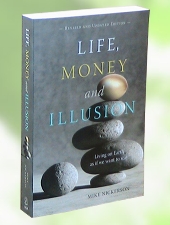The whole story:

Life, Money
and Illusion
The Right Amount
by Alan AtKisson
My friend from Sweden has two towels. Actually she has three, but the third she uses only for travel. When the bathroom towels are dirty, she washes them. When they wear out, she buys two more -- and very good ones, so they'll last a long time. "Why do I need more than two?" she says. "Det är lagom."
What she said in Swedish does not exactly translate to "This is enough." The word "lagom" -- pronounced melodically, the "la" a falling tone, the "gom" (rhymes with "home") a shorter syllable that's right back up where the "la" started -- means something like, "exactly the right amount." What a delight to learn this word!
When it comes to thinking about responses to over-consumption and consumerism, we are stuck, in English, with far less pleasing words. "Enough" sounds to most American ears as though it had the word "barely" just in front of it. For some reason, "enough" never sounds like ... enough. "Balance" sounds difficult; I'm always losing mine. "Sufficiency" carries the whiff of technical economic jargon. Even "simplicity," the current fad-word-of-the-moment in some marketing circles, tends to appeal only to those folks with either a moral commitment or a serious case of overwhelm. We need a concept for thinking about how much, in terms of stuff, is the right amount -- and the Swedes have given us a word for it.
The concept of "lagom" can be applied to everything from cake to carbon dioxide emissions. What is "lagom" for chocolate cake? For me, it's usually a little bit more than "enough." But what's "lagom" for CO2? Only as much as the ecosystems of the Earth can reabsorb, and no more. "Lagom" allows for more than enough -- but it still sets limits.What if our society were organized around the concept of "lagom"? Not that Sweden is organized that way; although my friend is hardly an extremist, she is a more enthusiastic "lagom"-ist than many of her fellow Swedes. (Imagine the Vikings taking only "lagom" when they plundered!) And most (North) Americans would have trouble just pronouncing it. But I have developed a small fascination with this word, because it has an attractive quality that "enough," "sufficient," and even "simple" often lack.
Most people in the world do not want enough. They want more. They certainly want more than the bare minimum, and research suggests they want more than those around them. This desire for more seems to be deeply wired in the human organism. We developed over millennia in hostile environments, both natural and social. To have more than we need has always been our first defense against the vagaries of an uncertain future. Hoarding is the first act of those who believe themselves to be in the path of a storm (or a marauding army of plundering Vikings, for that matter).
So while there will always be those of us who love the idea of "enough-ness" and "voluntary simplicity," it seems likely that such concepts will never quite be ... well ... enough to transform the masses of humanity (or the marauding army of corporations vying to fill their houses with stuff, in a kind of reverse-plunder operation). But it does seem possible to promote a sensible Swedish sense of "lagom" worldwide -- if we can find other good words for it -- because it speaks more to what people actually want.
Let's admit that it's very nice to have good shoes. No one can be faulted for wanting them. But does a person really need fifteen pairs? No. But is one pair enough? Perhaps not. "Lagom" acknowledges that people have varying needs and desires at different times.They want nice things, and comfort, and security. They want more than the bare minimum, and they might even need it. If their desire for more than enough is accepted, even supported, perhaps they would be more willing to consider how much is too much.Clearly, here in (North) America, we are far beyond the limits of "lagom." Once in a while I make a point of wandering into a Costco or a Sam's Club -- huge retail warehouses full of consumer goods, on sale cheap. The spaces are large enough to house a submarine assembly plant. You can buy everything from taco shells to trampolines to model wooden boats, by the crate. The shopping carts are as big as a small car. Walking around the aisles of one of these stores allows me to indulge in several radically different feelings: raw consumer lust, great moral outrage, and aching environmental angst. But when I took my same Swedish friend to see one of these places, her response was more practical. "I suppose people can save quite a lot of money here," she noted. "And it's better to buy some things in larger quantities." (Not towels.) "But perhaps it's just very tempting to take too much in such a place."
Nobody really needs too much, and in fact, most people don't really want it. But nobody wants too little. Perhaps our vision for a sustainable world should include not just enough for all, but "lagom" for all, with fewer temptations to take too much. And while I could write a great deal more about this lovely new addition to my vocabulary, perhaps this page, too, is "lagom."
Alan AtKisson is the author of Believing Cassandra: An Optimist Looks at a Pessimist's World. He is president of AtKisson and Associates, Inc., a consulting firm focused on accelerating sustainable development. He is also a Senior Fellow with the independent policy institute Redefining Progress, and formerly its program and executive director. Mr. AtKisson is a member of the board of directors of the Center for a New American Dream. This article is distributed courtesy the Center for a New American Dream's Syndicated Column Service. For more information about the Center, click on http://www.newdream.org/ or call (877) 68-DREAM.
